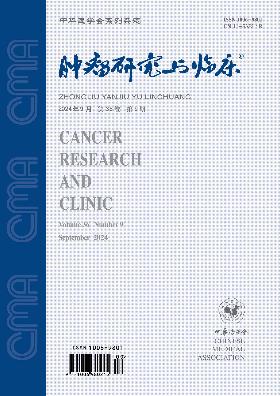CT-guided versus ultrasound-guided percutaneous lung puncture biopsy in the diagnosis of peripheral pulmonary masses: a Meta-analysis
Q4 Medicine
引用次数: 0
Abstract
Objective To systematically evaluate the efficacy and safety of CT-guided percutaneous lung puncture biopsy versus ultrasound-guided percutaneous lung puncture biopsy. Methods Relevant domestic and foreign related databases such as PubMed, Web of Science, Cochrane Library, OVID, China Biology Medicine, VIP, Wanfang and CNKI databases were searched, the randomized controlled trial about the applications of CT-guided and ultrasound-guided percutaneous lung puncture biopsy were collected. After extracting the relevant data, a Meta-analysis was performed using RevMan 5.2 and Stata softwares. Results Ten studies met the inclusion criteria, with a total sample size of 1 158 cases, of which 635 were CT-guided puncture biopsy and 523 were ultrasound-guided puncture biopsy. Meta-analysis showed that the difference of the success rate between the CT-guided group and the ultrasound-guided group was not statistically significant [97.48% (619/635) vs. 96.56% (505/523), RR= 1.01, 95% CI 0.99-1.03, P= 0.360]; the puncture diagnosis rate in the CT-guided group was lower than in the ultrasound-guided group, and the difference was statistically significant [92.44% (619/635) vs. 96.56% (505/523), RR= 0.97, 95% CI 0.94-0.99, P= 0.007]. The total incidence of complications after puncture in the CT-guided group was higher than that in the ultrasound-guided group, and the difference was statistically significant [14.49% (92/635) vs. 9.56% (50/523), RR= 1.56, 95% CI 1.11-2.19, P= 0.010]; the incidence of pneumothorax after puncture in the CT-guided group was higher than that in the ultrasound-guided group, and the difference was statistically significant [11.50%(73/635) vs. 6.31% (33/523), RR= 1.77, 95% CI 1.17-2.68, P= 0.007]; the difference of the incidence of bleeding after puncture between the CT-guided group and the ultrasound-guided group was not statistically significant [2.99% (19/635) vs. 3.25% (17/523), RR= 1.08, 95% CI 0.59-1.98, P= 0.800]. Conclusions Both CT-guided and ultrasound-guided percutaneous lung puncture biopsy have good clinical diagnostic value. However, for the intrapulmonary masses shown by ultrasound, the ultrasound-guided lung puncture biopsy has a shorter operation time, lower cost, and higher safety. Key words: Biopsy; Punctures; Ultrasonogrophy; Computed tomography; Peripheral pulmonary masses; Meta-analysisct引导与超声引导下经皮肺穿刺活检诊断周围肺肿块的meta分析
目的系统评价CT引导下经皮肺穿刺活检与超声引导下经皮肺穿刺活检的疗效和安全性。方法检索PubMed、Web of Science、Cochrane Library、OVID、中国生物医药、VIP、万方、CNKI等国内外相关数据库,收集CT引导和超声引导下经皮肺穿刺活检应用的随机对照试验。提取相关数据后,使用RevMan 5.2和Stata软件进行Meta分析。结果10项研究符合纳入标准,总样本量为1588例,其中635例为CT引导下穿刺活检,523例为超声引导下穿刺活组织。荟萃分析显示,CT引导组和超声引导组的成功率差异无统计学意义[97.48%(619/635)vs.96.56%(505/523),RR=1.01,95%CI 0.99-1.03,P=0.360];CT引导组的穿刺诊断率低于超声引导组,差异有统计学意义[92.44%(619/635)vs.96.56%(505/523),RR=0.97,95%CI 0.94-0.99,P=0.007]。CT引导组穿刺后并发症的总发生率高于超声引导组,差异具有统计学意义[14.49%(92/635)vs.9.56%(50/523),RR=1.56,95%CI1.11-21.19,P=0.010];CT引导组穿刺后发生率高于超声引导组,差异有统计学意义[11.50%(73/635)vs.6.31%(33/523),RR=1.77,95%CI 1.17-2.68,P=0.007];CT引导组与超声引导组穿刺后出血发生率差异无统计学意义[2.99%(19/635)vs.3.25%(17/523),RR=1.08,95%CI 0.59-1.98,P=0.800]。然而,对于超声显示的肺内肿块,超声引导下的肺穿刺活检手术时间更短,成本更低,安全性更高。关键词:活检;穿孔;超声造影;计算机断层扫描;周围性肺部肿块;Meta分析
本文章由计算机程序翻译,如有差异,请以英文原文为准。
求助全文
约1分钟内获得全文
求助全文
来源期刊

肿瘤研究与临床
Medicine-Oncology
CiteScore
0.10
自引率
0.00%
发文量
7737
期刊介绍:
"Cancer Research and Clinic" is a series of magazines of the Chinese Medical Association under the supervision of the National Health Commission and sponsored by the Chinese Medical Association.
It mainly reflects scientific research results and academic trends in the field of malignant tumors. The main columns include monographs, guidelines and consensus, standards and norms, treatises, short treatises, survey reports, reviews, clinical pathology (case) discussions, case reports, etc. The readers are middle- and senior-level medical staff engaged in basic research and clinical work on malignant tumors.
 求助内容:
求助内容: 应助结果提醒方式:
应助结果提醒方式:


